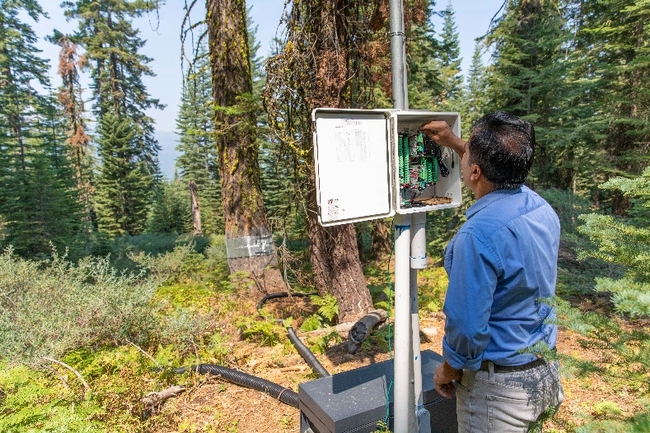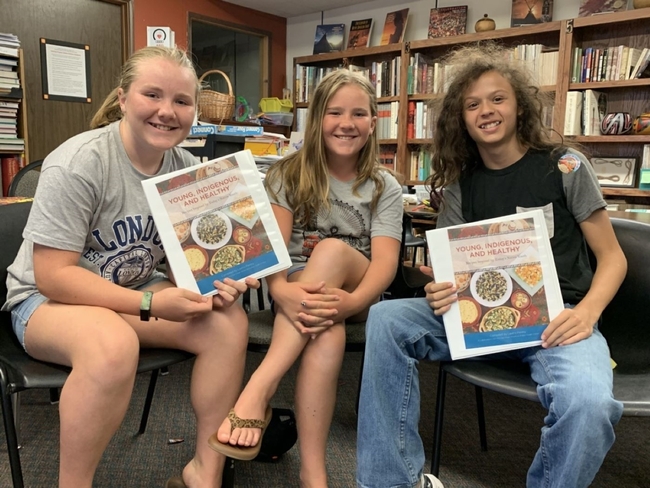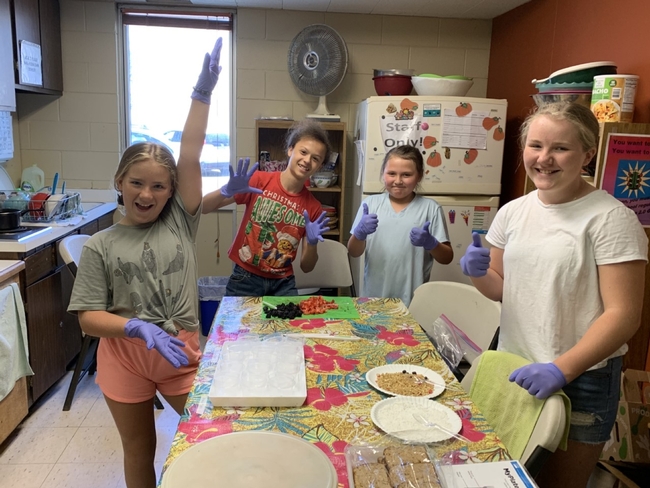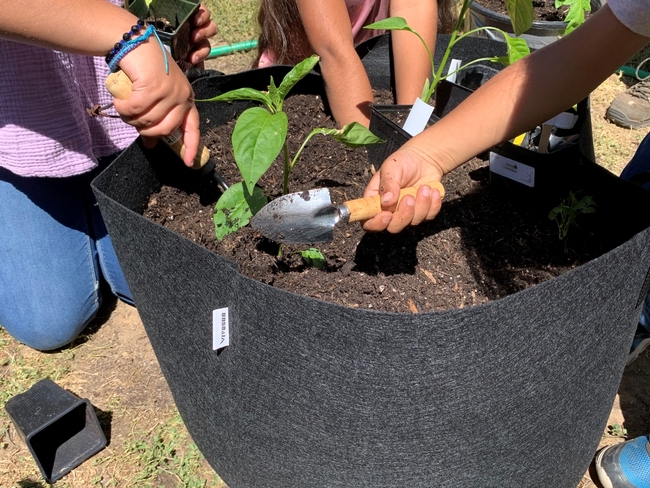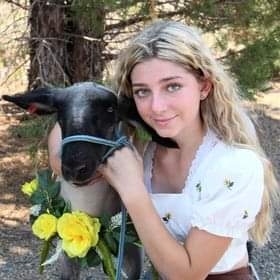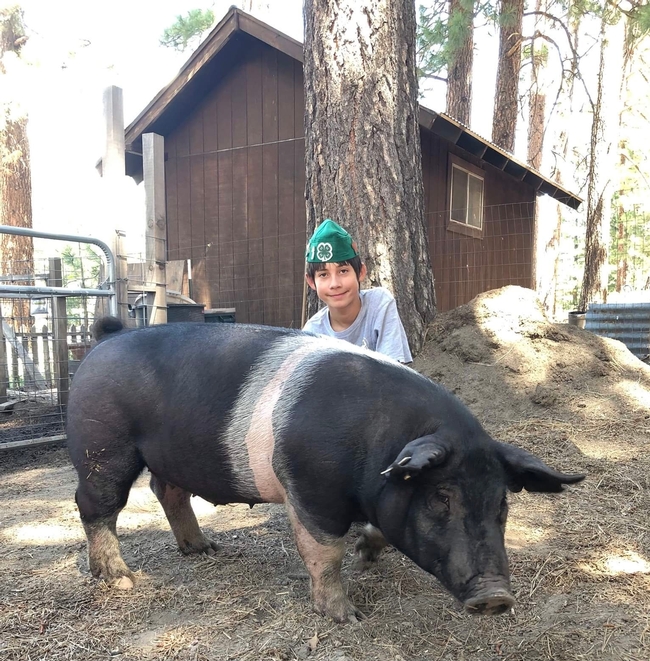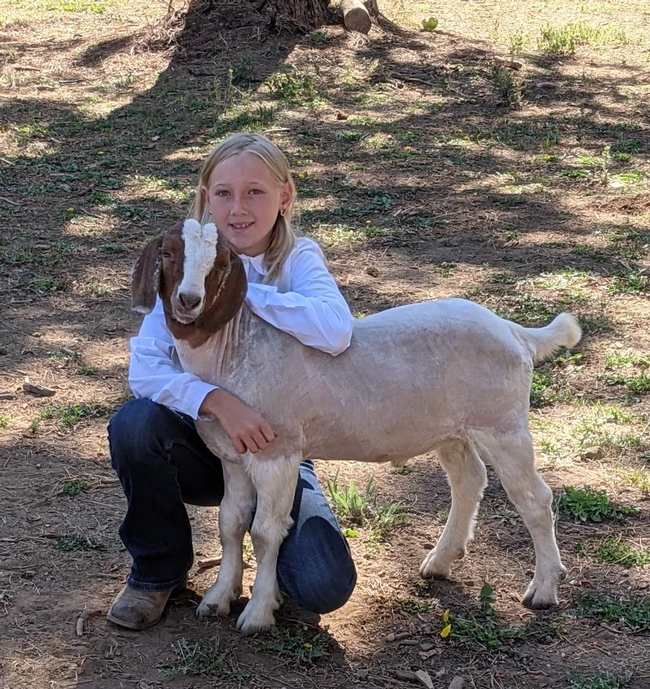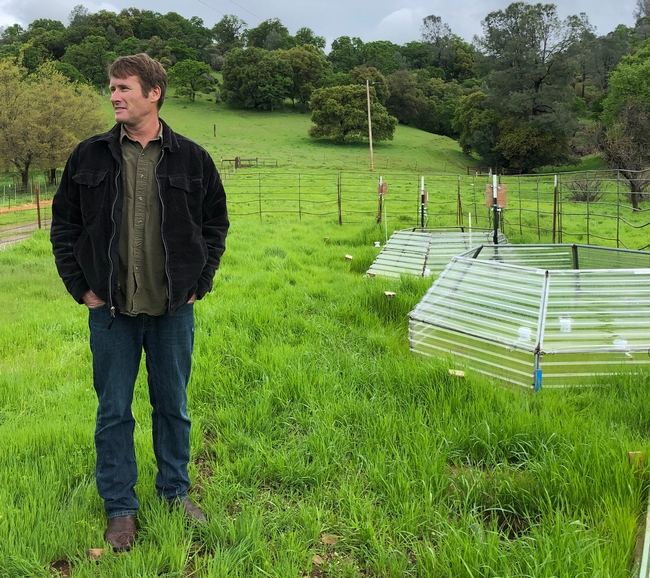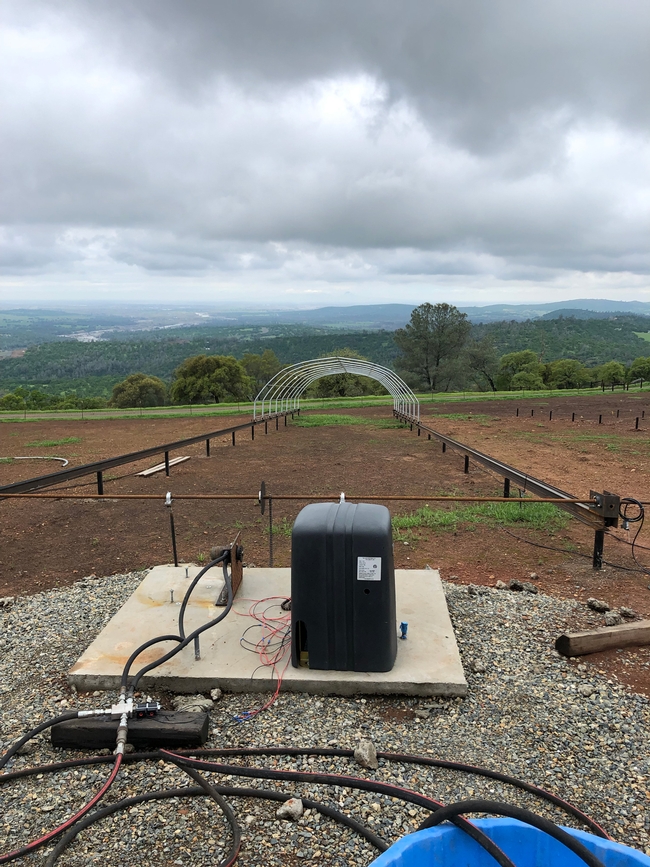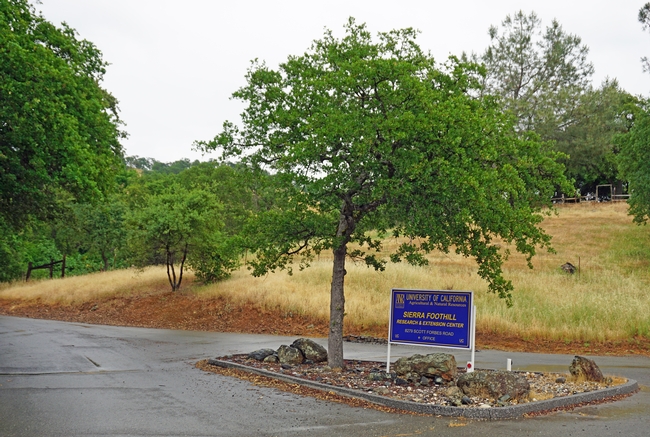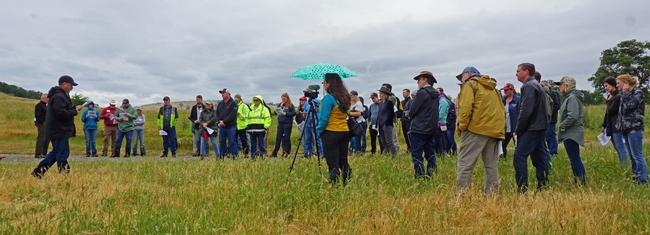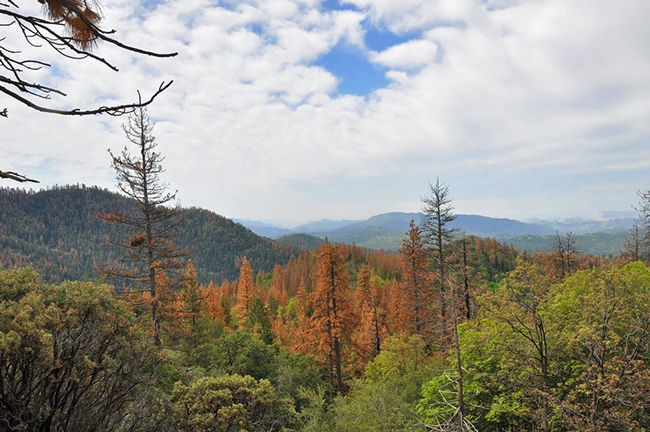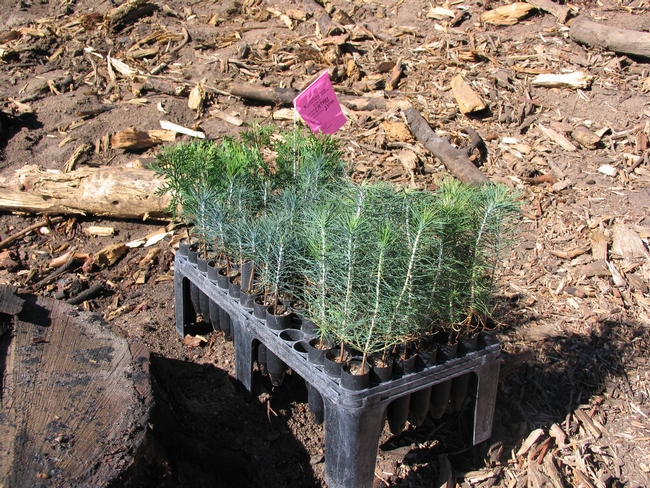Posts Tagged: Sierra
French Meadows partnership completes fourth season of work
Safeeq Khan of UC ANR among collaborators on forest treatments in the Sierra
Despite the challenges of an extremely dangerous fire season, including California's largest wildfire in 2022 (Mosquito Fire) impeding access and limiting operations, partners of the French Meadows Forest Restoration Project have wrapped up their fourth season of forest treatments in the critical headwaters of Tahoe National Forest. Safeeq Khan, Cooperative Extension specialist in water and watershed sciences with UC Agriculture and Natural Resources, is among the collaborators.
This season, project partners safely treated over 700 acres of federal land using a combination of mastication, mechanical thinning, hand thinning and prescribed fire. On adjacent private land, the American River Conservancy independently raised funds and treated 338 acres. Combined, this all-lands collaborative watershed management project has treated over 6,000 acres in just four seasons.
Work this season focused on areas most prone to wildfire ignition. The United States Forest Service treated over 200 acres with prescribed pile burns in and around the Talbot campground, improving the aesthetic quality of this important recreation area just north of French Meadows Reservoir. Although dry conditions limited the scope of prescribed burns this year, using fire as a management tool is a cost-effective way to maintain forest conditions that contribute to ecosystem resilience and human health and safety.
“Prescribed burns are a critical component of the partnership's ecological forestry model,” explained Edward Smith, forest ecologist and fuels manager with The Nature Conservancy. “Under ‘prescribed conditions' of wind, moisture and temperature, broadcast burning helps reduce the amount of tinder on the forest floor as well as fuel ladders that could otherwise carry wildfires into the tops of trees, protecting habitat for humans and diverse wildlife species. Fire also reduces brush and twigs to ashes that feeds the roots of trees and understory plants, protecting the soil and its microbial universe, making them more resilient to drought, insects and climate change.”
Mechanical thinning, hand thinning, and mastication operations continued in areas surrounding water research instrumentation, installed by the Sierra Nevada Research Institute at the University of California, Merced. Over the coming years, researchers will be assessing how vegetation changes in ecologically-based forest management affect water quantity in the local watershed.
“Optimal restoration of forested headwaters benefits from dedicated partnerships collecting scientific data,” said Khan, who is also an adjunct professor of civil and environmental engineering at UC Merced. “UC Merced is working to provide this dimension at French Meadows with strategic measurements and modeling.”
Perhaps the partnership's biggest success in 2022 was securing, via multiple grants, the remaining funding necessary to complete all the thinning operations defined in the original project plan. Since the project's inception more than six years ago, the partnership has operated under an innovative funding arrangement consisting of local, state and federal dollars combined with private donations.
“What has impressed me most about the French Meadows partnership is its commitment to see the project all the way through: start to finish,” said Tahoe National Forest Supervisor Eli Ilano. “With the new funding secured this year, we will be able to wrap up thinning operations, and turn our focus to managing and maintaining the land for the enjoyment of the public.”
American River District Ranger Mary Grim with the U.S. Forest Service added, “This partnership learns from each year to adaptively manage for resilient forests that benefit everyone. The French Meadows Project is a reminder of what can be accomplished with a shared sense of stewardship for our forests and natural resources.”
Fuels reduction work this season resulted in more than 1.066 million board feet of overstocked timber, which was brought to a local mill, with the revenue generated offsetting some of the restoration costs. Project partners also repaired over seven miles of roadway and culverts to reduce sedimentation.
“Under the threat of a second consecutive severe fire season, including the Mosquito Fire in our own ‘backyard,' the partnership diligently moved treatment activities forward and began discussions on how to sustain the project's benefits through long-term maintenance planning,” said Kerri Timmer, regional forest health coordinator with Placer County, who coordinates the stewardship agreement with the Tahoe National Forest.
The catalyst of the French Meadows Forest Restoration Project was the 2014 King Fire, which burned over 97,000 acres in the American River watershed, much of it at high intensity. Eager to reduce the risk to hydroelectric assets, water quality, and biodiversity from future high severity wildfires, Placer County Water Agency joined with Placer County, The Nature Conservancy, the United States Forest Service, American River Conservancy, Sierra Nevada Conservancy, and the Sierra Nevada Research Institute at the UC Merced, to form the French Meadows Partnership.
The project spans more than 22,000 acres of federal land, nearly 7,000 acres of private land, and is a test case for the partnership's effectiveness in improving fire resilience and the overall health of the watershed.
To learn more about the French Meadows Forest Restoration Project, visit and tour the Project's story map.
CalFresh Healthy Living, UC helps connect Native youth with Native foods
Program with Foothill Indian Education Alliance teaches healthy eating to young people of many tribes
More than a tutoring center, the Foothill Indian Education Alliance facility in Placerville also provides cultural activities for youth in El Dorado and Amador counties affiliated with a broad diversity of Native American tribes.
In addition to traditional crafts like drum- and jewelry-making, the center began offering a food component last summer, through a partnership with CalFresh Healthy Living, University of California – one of the agencies in the state that teaches nutrition to people eligible for SNAP (Supplemental Nutrition Assistance Program).
“A lot of the kids, because they don't live on a reservation or their family might not be connected to a local tribe, don't know a lot of their history or their foods,” said Cailin McLaughlin, nutrition educator for CalFresh Healthy Living, UC, based at the UC Cooperative Extension office in El Dorado County. “Food is a good way to explore any heritage because food is at the central point of a lot of cultures and customs – sharing meals and sharing stories behind it.”
Last spring, McLaughlin worked with Hal Sherry, the head tutor at Foothill Indian Education Alliance, to create a new, five-week “summer camp” during which youth would learn about and prepare Native foods in the center's kitchen, primarily with ingredients from its backyard garden.
Sherry said that the experience provided the participants – 10 elementary school students and seven middle or high school students – an important perspective on the interconnectedness of all living things.
“Part of the objective of the program is for them to understand that each one of us is part of the natural order of things, and that we have to do our part to fit into that cycle,” he explained. “There's kind of an ecological lesson that's also being learned…and we don't want to put poisons in our bodies, and we don't want to put poisons in our environment.”
Program combines cultural lessons, nutrition information
For the summer program, McLaughlin selected a curriculum centered on garden-based nutrition, and infused it with elements of Indigenous food ways.
“We predominantly picked ingredients that had cultural significance to Native American communities, so things like blueberries, blackberries, pine nuts, squash, things of that nature,” she said. “So we could feed into the history of that ingredient, why it's important to the Indigenous communities – and then give (the students) the nutritional information about it.”
After the youth prepared chia seed parfaits – from a recipe that is part of a series developed by CalFresh Healthy Living, the California Indian Museum and Cultural Center, and the Center for Wellness and Nutrition – a Foothill Indian Education Alliance staff member shared that Native hunters would eat chia seeds for strength before a long hunt.
Many of the participants had never had chia seeds before, and the parfaits were an “absolute favorite,” in the words of McLaughlin.
“I wish we could have made them more often!” said Lacey, a fifth grader who participates in the center's programs year-round.
In addition to working outside in the garden, Lacey said she also liked cooking in the kitchen during the summer camp – and the fact that the young people could take the lead.
“It was all the kids doing it, but (McLaughlin) was just supervising and making sure we were doing it right – it was really nice,” said Lacey, who identifies as Miwok.
Sharing within families, across tribes
Active participation by the young people is one of the strengths of the program, according to Sherry. He expressed admiration for McLaughlin's engaging teaching style, which eschews “lectures” and instead draws the participants into lively conversations about the nutritional content of the ingredients.
“Hopefully they're going to retain some of that knowledge and information and then remember: ‘You know what, yes, I think I would like to have some corn and some beans tonight, because that's going to help my bones grow strong and my eyesight get better,'” Sherry said. “That's really a big part of what we want them to come away with.”
At the end of the summer program, participants also came away with a binder of recipes from a cookbook of Native American dishes, “Young, Indigenous and Healthy: Recipes Inspired by Today's Native Youth.” James Marquez, director of the Foothill Indian Education Alliance, said he heard from students that they were bringing many of the lessons from the program back to their homes.
“I've heard the same kind of thing from parents and grandparents, who have said how wonderful that was and that kids come back home and have an interest in cooking and trying to serve nutritious meals to their families,” Marquez said.
That crucial sharing of knowledge also happens between and among staff members and students, as the center comprises members of many tribes, from South Dakota Lakota to Navajo.
“We serve Native people, we don't care what tribe they come from – they're all welcome,” Marquez said. “What we do represents a lot of different tribes, so we share information from one tribe to another, and that way people can appreciate everybody and what we have to bring to the table.”
Talia, a sixth grader who participated in the summer program, said that she enjoys that cultural sharing.
“I like how I can learn new things…and how I learn more about the people around me,” she explained. “It's also fun to learn about other people's cultures, and what Native American they are, too.”
McLaughlin went on to partner with Foothill Indian Education Alliance on a “Cooking Academy” program during this past fall, and is planning another spring/summer program for 2023, as well. The ongoing teaching and sharing of food ways is just one part of a long process to recover and rebuild Native American cultural traditions.
“Unfortunately, there was a very concerted effort to obliterate the Native culture on this continent; it was a very intentional, very deliberate effort to just stamp that culture out like it had somehow never existed,” Sherry said. “Now there's a much greater awareness of what a terrible thing that was, and so it's like trying to regrow a new garden over an area that was severely burned…and it's being done all over the country.”
Despite Dixie Fire, Plumas-Sierra youth look for bids on livestock
Due to the Dixie Fire, the traditional Plumas County Fair was canceled; however, volunteers are working hard to make the Plumas-Sierra Junior Livestock Show happen. 4-H and FFA youth will show their prize-winning livestock this weekend at the Sierraville Roping Grounds. The showing of animals is scheduled to take place on Aug. 13 and 14 with the Junior Livestock Auction on Sunday, Aug. 15.
“We really hope junior livestock supporters in the region and beyond will raise their hands often this year to support the youth livestock producers of Plumas and Sierra counties,” said Megan Neer, Plumas-Sierra Junior Livestock Auction chairman.
“The kids have overcome the challenges of COVID and now face another year of canceled county fair due to the Dixie Fire,” Neer said. “Many of our youth have been directly impacted by the fire evacuations and some even have lost homes to the catastrophic fire. We are really looking to the community and beyond to support our youth during this difficult time.”
Profiles of participating youth can be viewed on the Plumas-Sierra Junior Livestock Auction Facebook page by clicking on “Photos." Interested buyers can participate in the livestock sale on Sunday, Aug. 15, and help reward the young people for their hard work in raising steers, lambs, swine, goats, rabbits, turkeys and other animals.
On the Plumas-Sierra Junior Livestock Auction website there is an option to donate to the Dixie Fire Relief Fund. There will be opportunities on sale day to support the 4-H members who were affected by the fire. In addition, there is an option for add-ons to support a child separate from buying an animal – for both 4-H and FFA members – that are in the sale.
“We would like to thank volunteers and sponsors for coming together on such short notice to host the livestock show event for my fellow 4-H and FFA exhibitors as well as myself,” said Kristin Roberti, Sierra Valley 4-H president, who has a steer entered in the event. “I will be joining over 100 other youth exhibiting livestock at the event this year, including a number of friends who have been impacted by the ongoing Dixie Fire and the Beckwourth Fire last month.”
UPDATE Aug. 24, 2021: The auction raised over $500,000.
"It was an amazing day, and life changing for many youth that were impacted the hardest by the Dixie Fire," said Tracy Schohr, UC Cooperative Extension livestock and natural resources advisor in Plumas and Sierra counties.
"Also, the day before the auction I worked with the Plumas-Sierra Cattlemen to host an impromptu dinner and auction to support ranchers impacted by the Dixie Fire - over $30,000 was raised that will go to ranchers who lost feed, hay, fences and many who have incurred tremendous costs the past month while the fire has burned around them," Schohr said.
"The weekend activities were a true reminder of the support for agriculture, support for youth in agriculture, value of community and the true power of social media."
For more information about the auction, visit plumas-sierrajla.com or contact Jane Roberti, advertising coordinator, at (530) 249-4036 or (530) 993-4097.
UC ANR research to determine future climate change impacts today
Scientific evidence of a warming climate in California and across the globe is clear, but the impacts on ecosystems and agriculture are still difficult to predict.
Sophisticated computer models are used to forecast future climate. Understanding that temperature and precipitation levels will change in the future does not tell the full story: UC Agriculture and Natural Resources researchers also want real-world experience under those future conditions.
Moreover, some agricultural operations have higher sensitivity to the changes than others. Rangeland forage is particularly sensitive to climate changes since, unlike irrigated agriculture, ranchers rely solely on precipitation. They have no control over how much and when it rains.
“It's tricky business,” said rangeland expert Jeremy James, the director of the UC Sierra Foothill Research and Extension Center in Browns Valley. “It's not easy to forecast. We have to address the uncertainty in a realistic manner.”
Discovering climate change impact on rangeland
In order to study different climate projections on rangeland, James and Maggi Kelly, director of the UC ANR Informatics and Global Information Systems special program, have begun development of a research site that will allow scientists to manipulate the temperature and rainfall on sections of rangeland to understand what would happen under predicted weather scenarios.
With a $220,000 National Science Foundation grant, construction is now underway on a four-acre site at the research center that will help scientists learn how temperature and precipitation will impact growth and diversity of forage that ranchers use to raise their livestock.
“We need to know how rangelands will respond when conditions change,” James said. “Will we grow more, but dry out earlier? Will we have more medusahead (an undesirable rangeland weed) or more soft chess (a high quality forage)?”
When complete, 16 shelters on steel tracks will be connected to computer systems and hydraulic motors to move them up or down a research plot. The shelters and other equipment will allow scientists to precisely control the amount of precipitation (or irrigation water) that rains onto the plot. Other systems will give researchers control of air temperature.
“This facility isn't designed for one type of research,” James said. “It is designed to conduct a wide variety of research by scientists over the next several decades. With this setup, we can look at the effect of climate change on soil biological communities, soil carbon, insect communities, plant-insect interactions and oak seedling recruitment.”
The research results from the project should provide ranchers and land managers a better understanding of how climate change may impact agriculture and ecosystem function on rangeland while also providing important information on how to minimize impacts of these changes.
Some aspects of the research facility's development are not covered with funding from the National Science Foundation. The scientists are looking for additional support to complete the project.
For more information, contact James at jjjames@ucanr.edu.
Current work underway at the Sierra Foothill Research and Extension Center
The Sierra Foothill REC, a 5,000-acre facility on the Yuba River, has supported research, education and outreach in the Sierra foothills since 1960. Multiple lines of research are being conducted at SFREC. During a recent workshop, scientists from UC Davis, UC Berkeley and UC Cooperative Extension shared a sampling of their work at SFREC.
UCCE livestock and natural resources advisor Dan Macon described a project aimed at helping ranchers make decisions about maintaining a cattle herd when faced with impending drought. Ranchers are reluctant to sell off their cattle even when the near future weather forecast is dire.
“Science tells us you shouldn't feed your way out of a drought,” Macon said. “But you want everything to stay the same. You want to maintain your genetic potential and keep cows that are familiar with the area.”
Working with ranchers, the research project will compare management practices to determine the best way forward when the future looks meteorologically bleak.
“We're assigning cows to a traditional weaning and early weaning groups,” Macon said. “They'll be out on the range from March to early September under different parameters. We're also tying in economics, the value of genetic potential and the value of having cows who know the landscape.”
Research by University of Oregon post doctorate researcher Ashley Shaw is looking into whether compost applied to rangeland will help mitigate climate change by sequestering more carbon, and also benefit forage under drought by increasing the soil's water-holding capacity and improving nutrient delivery.
Preliminary results are promising. A single application of 1/4-inch of compost resulted in forage production that was higher than areas where no amendment was applied and areas that were treated with a chemical fertilizer.
“The biggest impact was under drought shelters,” said Shaw, referring to PVC frames that were covered with plastic during rain events to understand the impact of the treatment under dry conditions. “In the drought plots, the areas where compost was applied are staying green longer.”
A defining research tool at SFREC is a dataset that includes information on monthly rainfall and forage production going back 40 years.
A review of the data shows surprising variations and correlations at the center, where forage production averages 3,000 pounds per acre, but ranges from about 1,000 pounds per acre in 1987, to over 5,000 pounds per acre in 2018, when there was so much growth, “we didn't have enough animals to graze,” James said.
The dataset paints a spectrum of the variation that ranchers across the state must navigate to manage their livestock and rangeland in a way that is profitable and ecologically sound. Research at the Sierra Foothill REC offers invaluable information to help them better understand the ecosystem and make informed decisions.
Reevaluate the Sierra Nevada landscape after removing dead trees
This winter, a generous amount of rain and snow has fallen on California, but it can't erase the brown swaths of dead and dying trees in the Sierra Nevada caused by five years of drought and decades of forest mismanagement.
Fire suppression and the harvest of the largest and most resilient trees in the forest led to a large population of weak trees. The prolonged drought further weakened the trees' defenses against native insects. Aerial detection surveys show that more than 102 million trees have died since 2010; more than 62 million died in 2016 alone. Public and private landowners are now struggling to recover from this natural disaster.
UC Cooperative Extension forester and natural resources advisor Susie Kocher recommends dead trees be removed and the landscape reevaluated.
“The dead trees will eventually fall,” Kocher said. “Removing trees around homes and other buildings is especially important for safety. Also, when they fall on the ground they become large fuels on the forest floor, leading to more intense fires.”
The cost of removing the trees can be substantial. The State of California is funneling disaster relief funds through California counties, utilities are felling trees that pose a threat to power lines, and local jurisdictions are removing trees that could fall on roads and other public infrastructure. However, most tree removal is the responsibility of private landowners.
When the dead trees are gone, before considering replanting, Kocher suggests Sierra residents carefully assess what has survived.
“There is often a lot of live vegetation remaining,” Kocher said. “Make a map and mark where you find living trees and shrubs and identify them by species and size. If you have a significant number of trees left, you may not need to replant.”
Kocher suggests nurturing the remaining young trees.
“You may want to thin trees out so that available sun and soil moisture are focused on the healthiest individuals. Some watering in the summer may help counter stress caused by increased solar radiation,” she said.
If removing the dead trees leaves the landscape too bare, replanting native conifers is a good strategy. Conifers include pine, cedar and fir trees, but in California's dense forests, firs and cedars – which do well in shady conditions – are beginning to dominate. Replanting may be a time to give native pines – such as Jeffrey, ponderosa and sugar pines – a chance to recover ground.
“The fact that many pines have died does not necessarily mean they are no longer adapted to your location, even with our warming climate,” Kocher said. “There may be a few locations that are less suitable for trees that have grown there in the past, but for most areas, local growing conditions should support native conifers in the near future.”
Native plants and shrubs that died during the drought or were damaged during tree removal will likely come back on their own without replanting. Shrubs and oaks can re-sprout and native herbaceous plants generally store seed in the soil that will grow under native rainfall conditions.
Replanting of trees also gives landowners the chance to shape the landscape for best effect. Kocher offers the following recommendations on replanting trees in natural landscapes:
- Space trees at least 10 feet apart.
- Trees and flammable vegetation should be kept at least 10 feet away from the home, planted sparsely within 30 feet of the home and spaced widely enough in the 30 to 100-food zone so the crowns of the trees will not touch when they are mature. Beyond 100 feet, trees can fill into a more natural looking forest.
- Plant trees at least 10 feet from power lines.
- Do not plant trees within the road right of way to prevent interference with snow clearance, maintenance and construction projects.
- Plant pines where there is a lot of sun. Do not plant sugar pine on the driest sites.
- Avoid planting where the mature trees will block desired views.

